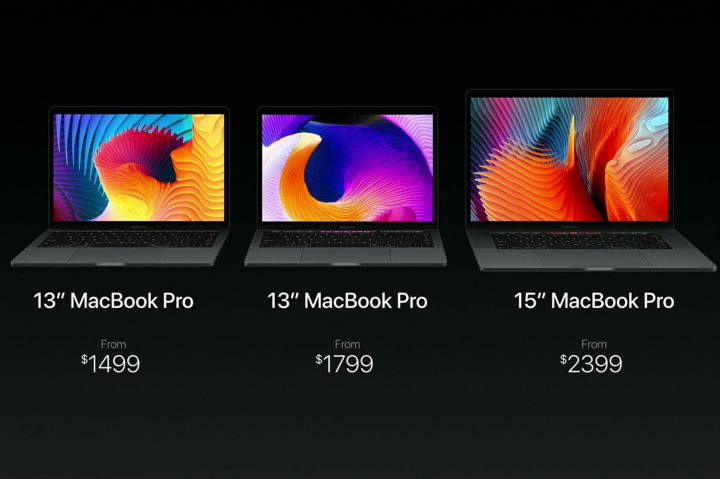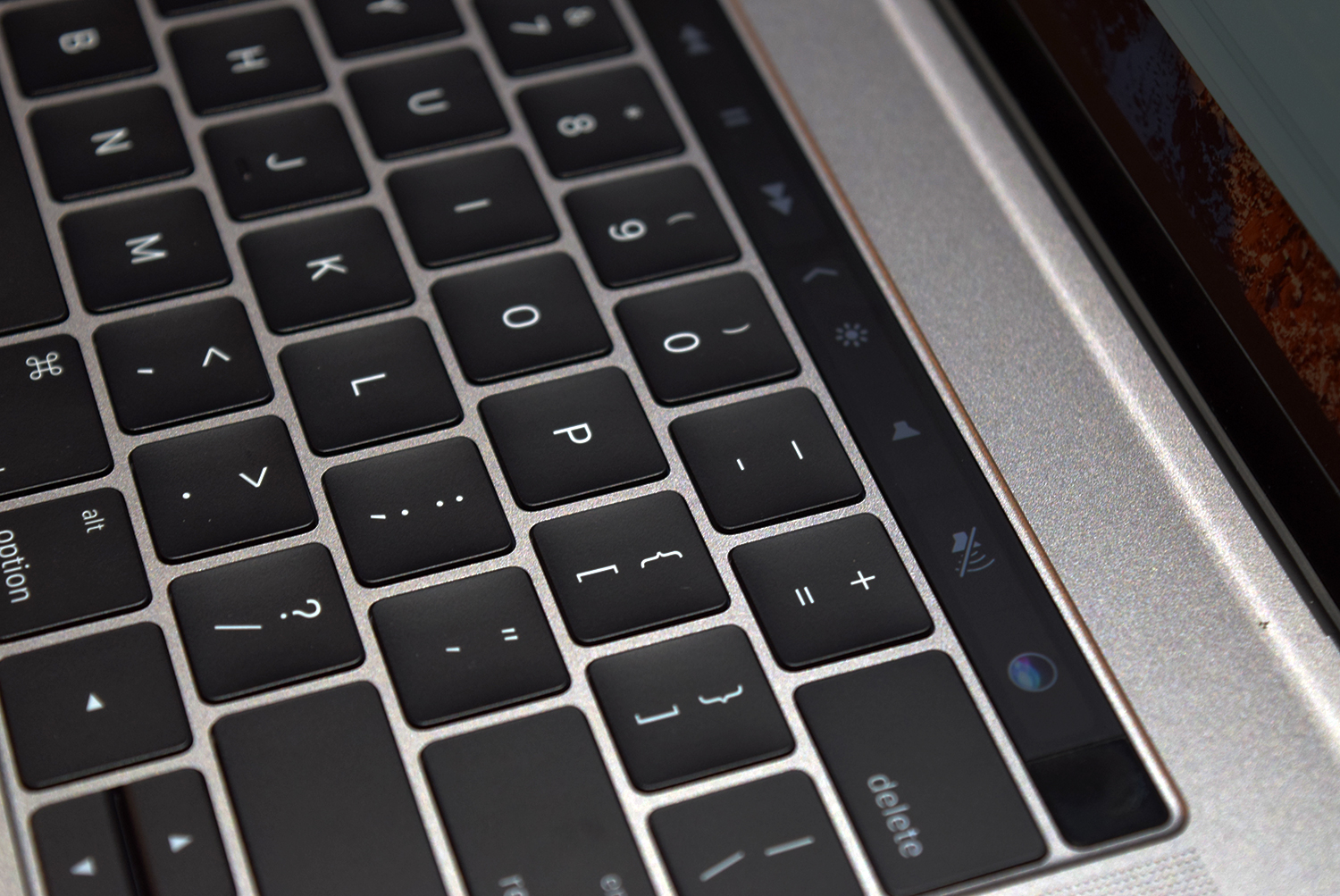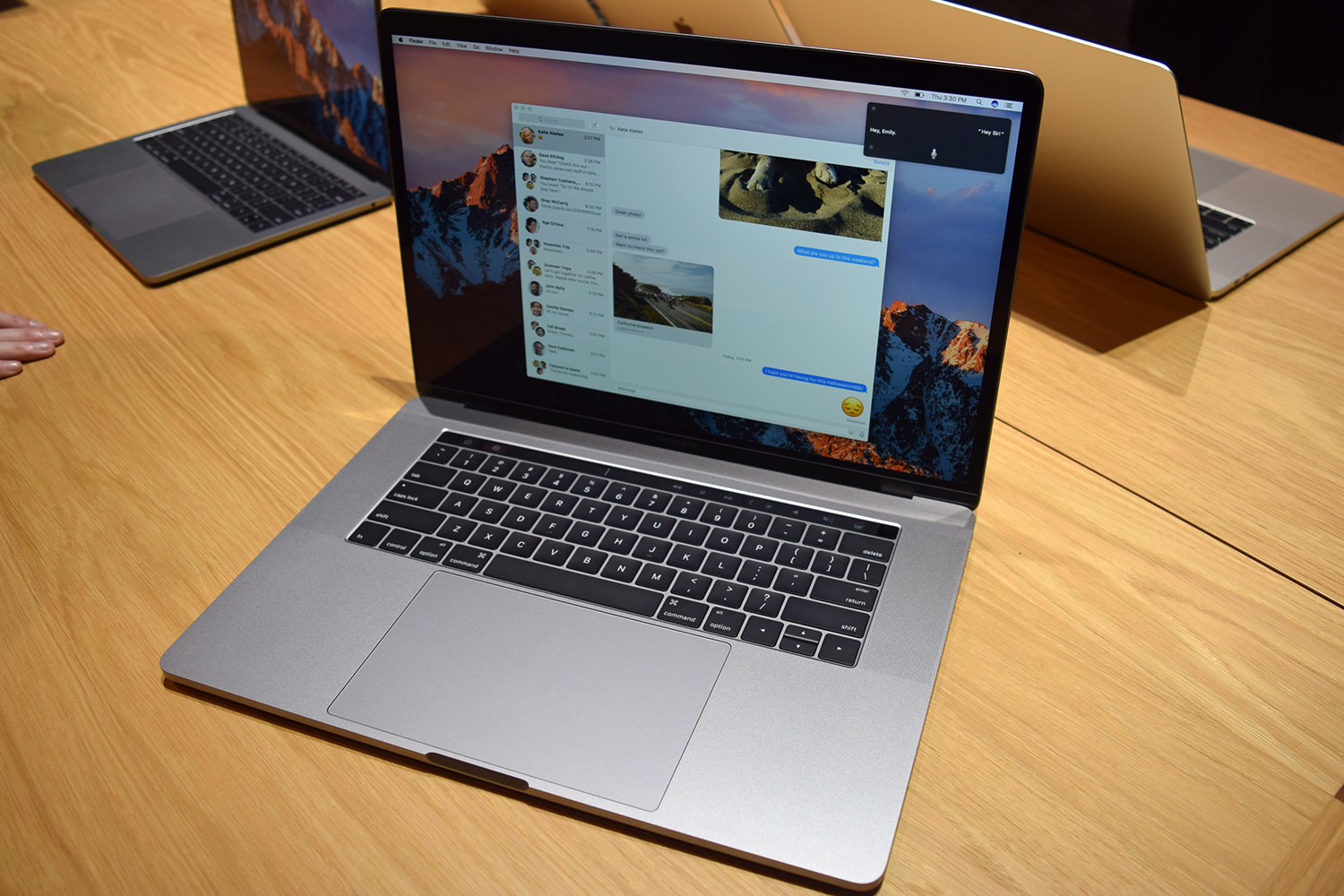
It’s a new world out there for the MacBook Pro, so with that in mind let’s take a look at every change that Apple made for this new iteration.
New, slimmer design
Apple unveiled three new MacBook Pro models. Two 13-inch models and one 15-inch model, all of which received a number of design updates, though only the two higher-end options received the context-sensitive touch screen, the Touch Bar.
The new MacBook Pro lineup features a number of changes to the iconic external design, including the removal of the glowing apple from the back of the monitor. Taking its place is a glossy apple engraved into the aluminum unibody. More importantly, all three received a major update to their overall profile. They’re slimmer, lighter, and according to Apple, better built than ever before.
| MacBook Pro 13-inch | MacBook Pro 13-inch with Touch Bar | MacBook Pro 15-inch with Touch Bar | |
| Dimensions | 0.59 x 11.97 x 8.36 inches | 0.59 x 11.97 x 8.36 inches | 0.61 x 13.75 x 9.48 inches |
| Weight | 3.02 pounds | 3.02 pounds | 4.02 pounds |
| Display | 13.3-inch 2,560 x 1,600, 60Hz Retina Display | 13.3-inch 2,560 x 1,600, 60Hz Retina Display | 15.4-inch 2,880 x 1,800, 60Hz Retina Display |
| Inputs | 2x USB-C Ports, 1x 3.5mm headphone jack | 4x USB-C Ports, 1x 3.5mm headphone jack | 4x USB-C Ports, 1x 3.5mm headphone jack |
| Battery Life | Approximately 10 hours | Approximately 10 hours | Approximately 10 hours |
Additionally, all three MacBook Pros feature the same revamped keyboard with updated butterfly switches, and make the leap to a Force Touch trackpad. These two elements might not seem like much, but they’re the two aspects of a notebook that the user interacts with most, so quality is key here.
All about the Touch Bar
While only two of the new MacBook Pro models features the Touch Bar, it’s easily the most recognizable feature of the new lineup. It’s something nobody else has, and it’s a pretty cool little addition to an already solid laptop. The Touch Bar features a context-sensitive multi-touch display built on OLED technology, in the place of a row of function keys. The Touch Bar still fulfills the role those keys once played, offering up a standard set of options like brightness, playback, and volume control.
The most eye-catching feature of the Touch Bar the way it interfaces with your apps. If an app supports the Touch Bar, it will transform based on what you’re currently working on. Apple showed off some of that functionality at the event, illustrating the numerous ways a user might interact with the Touch Bar.
We saw the multi-touch display transform into a color wheel, a tool to control playback in a video editing suite, and even a row of emojis. It’s a really versatile feature, and if it ends up working the way Apple says it will, you might find yourself using your Touch Bar more than you ever used those dusty old function keys.
Also of note, the Touch Bar integrates support for Apple’s Touch ID system directly into the MacBook Pro’s power button. So, instead of keying in your credit card information, now you’ll be able to just authorize purchases with a touch of your finger. However, the most affordable MacBook Pro does not support this feature.
Want to know more? Read our in-depth look at what the Touch Bar does, and how it interacts with apps. Or go read our full review of the MacBook Pro.
What’s in the MacBook Pro 13 without Touch Bar
This model’s defining feature is the lack of a certain feature, the much-anticipated Touch Bar. By cutting out the OLED strip, and Touch ID support along with it, the MacBook Pro 13-inch is the cheapest in the new MacBook Pro lineup. Starting at $1,500 it’s certainly not a budget laptop, but after taking a peek under the hood, it sure looks like one.
With only two processor options, the MacBook Pro 13-inch is the least versatile – and least expensive – MacBook Pro. It features only two 6th-generation Skylake processor options, an Intel Core i5 and an Intel Core i7. Both are dual-core, and despite only a marginal increase in clock speed, the Core i7 adds some serious heft to an already high price tag.
|
MacBook Pro 13 without Touch Bar Processors |
||
| Processor SKU | Clock Speed | Price |
| Intel Core i5-6360U | 2.0 GHz dual-core, Turbo Boost up to 3.1GHz, with 4MB shared L3 Cache | Standard |
| Intel Core i7-6660U | 2.4 GHZ dual-core, Turbo Boost up to 3.4GHz, with 4MB shared L3 cache | +$300 |
Both are low voltage options from Intel, which likely accounts for the impressive battery life quotes Apple has advertised on this model’s spec sheet. The Intel Core i5-6360U launched in the third quarter of 2015, while the Core i7-6660U launched in the first quarter of this year. Even though there’s not much of a visible boost in clock speed, the i7 option might be worth the extra cash considering it’s a newer chip and won’t show its age as quickly as the Core i5 might – and the i7 features an upgraded version of Intel’s Iris Graphics.
The other specs available for the 13-inch sans Touch Bar model are pretty standard, so there’s not much to get excited about here. It features three different storage specs, ranging from a relatively tiny 256GB to a respectable 1TB.
|
MacBook Pro 13 without Touch Bar Storage |
|
| 256GB PCIe-based SSD | Standard |
| 512GB PCIe-based SSD | +$200 |
| 1TB PCIe-based SSD | +$600 |
When it comes to memory, the MacBook Pro 13-inch comes outfitted with 8GB of 1866MHz RAM, and can be upgraded to 16GB for an extra $200.
Starting at $1,500 the MacBook Pro 13-inch puts itself in direct competition with more fully-featured notebooks like the Dell XPS 13, and even the Surface Book. While it can be outfitted with an upgraded processor, hard disk, and RAM, those upgrades can add up quickly.
Fully specced out, the MacBook Pro 13-inch (without Touch Bar) will run you around $2,600. Which is an awful lot of money for a notebook that doesn’t have a discrete GPU or a quad-core processor.
What’s in the MacBook Pro 13-inch with Touch Bar?

This is the model you’re most likely to see at your local coffee shop in the coming months, the MacBook Pro with Touch Bar. Starting at $1,800 it’s the most expensive 13-inch MacBook Pro that Apple has ever rolled out, and boasts some impressive hardware to go along with that impressive price.
Processor & Storage
The MacBook Pro 13-inch Touch Bar model features three CPU options, two Intel Core i5s and one Intel Core i7, all of which are dual-core processors. Let’s dive into those SKUs.
|
MacBook Pro 13 with Touch Bar Processors |
||
| Processor SKU | Clock Speed | Price |
| Intel Core i5-6267U | 2.9GHz dual-core, Turbo Boost up to 3.3GHz, with 4MB shared L3 cache | Standard |
| Intel Core i5-6287U | 3.1GHz dual-core, Turbo Boost up to 3.5GHz, with 4MB shared L3 cache | +$100 |
| Intel Core i7-6567U | 3.3GHz dual-core, Turbo Boost up to 3.6GHz, with 4MB shared L3 cache | +$300 |
Unfortunately, all three processors launched in the third quarter of 2015, so they’re not exactly cutting-edge technology. These processors do run with a higher thermal design power target than most Intel mobile dual-core processors, so that gives them a bit of an edge. But that’s blunted by the continued use of 6th-generation Intel Core processors, while most competitors have moved on to the 7th-gen.
Overall, these laptops are quick despite the aging processor hardware. But in many cases, past MacBook Pro models have held a clear lead over the competition. That’s not true now.
The MacBook Pro 13-inch with Touch Bar features the same range of storage capacity options as the cheaper sans-Touch Bar model, and the same memory options.
|
MacBook Pro 13 with Touch Bar Storage |
|
| 256GB PCIe-based SSD | Standard |
| 512GB PCIe-based SSD | +$200 |
| 1TB PCIe-based SSD | +$600 |
Though, with an already high entry price, increasing your memory or storage by even a modest amount will come at a serious cost. Fully specced out, the 13-inch MacBook Pro with Touch Bar is going to run you about $2,900.
What’s in the MacBook Pro 15-inch with Touch Bar?
Here it is, the big, bad 15-inch MacBook Pro. For years it was the luxury laptop of choice, an iconic notebook which ushered in an era of premium-quality laptops at the upper end of the performance and pricing spectrum. But during its long absence from annual product cycles, it fell behind the competition in nearly every way. With this latest revision, can Apple reclaim its place atop the premium laptop market with a high-performance, high-price, luxury laptop?
Processor & Storage
The MacBook Pro 15 with Touch Bar features three different processor options, a trio of Intel Core i7 quad-cores, with a little variation in clock speed. These guys are the real deal, the full-power top-of-the-line mobile quads. Short of a desktop CPU, or an upcoming 7th-generation Kaby Lake Core i7, these are some of the best processors you can find on a laptop.
|
MacBook Pro 15 with Touch Bar Processors |
||
| Processor SKU | Clock Speed | Price |
| Intel Core i7-6700HQ | 2.6GHz quad-core, Turbo Boost up to 3.5GHz, with 6MB shared L3 cache | Standard |
| Intel Core i7-6820HQ | 2.7GHz quad-core, Turbo Boost up to 3.6GHz, with 8MB shared L3 cache | +$100 |
| Intel Core i7-6920HQ | 2.9GHz quad-core, Turbo Boost up to 3.8GHz, with 8MB shared L3 cache | +$300 |
These high-performance processors don’t come cheap; they add on to an already exorbitant starting price of $2,400. But, it is worth noting that the 15-inch model MacBook Pro has never been a budget laptop.
Moving on to storage options, its luxury pedigree becomes even more apparent. The MacBook Pro 15-inch with Touch Bar features four different options for internal storage, ranging from a paltry 256GB to a massive 2TB, but that extra storage is going to cost you.
| MacBook Pro 15 with Touch Bar Storage | |
| 256GB PCIe-based SSD | Standard |
| 512GB PCIe-based SSD | +$200 |
| 1TB PCIe-based SSD | +$600 |
| 2TB PCIe-based SSD | +$1,400 |
This is where we’d discuss the memory options available for the MacBook Pro 15-inch with Touch Bar, but there aren’t any. It comes standard with 16GB of 2133MHz LPDD3 RAM, but doesn’t offer any opportunity to increase that to 32GB, and according to iFixit’s teardown, you can’t expand that memory yourself.
Graphics
With a discrete GPU, the MacBook Pro 15-inch with Touch Bar offers even more opportunities to kick up that price. The two GPUs available, the Radeon Pro 455 with 2GB of memory, and the Radeon Pro 460 with 4GB of memory, were announced in conjunction with the MacBook Pro.
For comparison, let’s look at the overall performance of the Radeon Pro 400-series and the Nvidia GeForce GTX 1060 with 3GB of memory, which is currently available on some
The GTX is rated at a compute power of 4.0 teraflops, while the Radeon Pro 450 can only handle 1.3 teraflops, and the Radeon Pro 460 fares slightly better at 1.86 teraflops. What does that mean for your graphical performance? Well, it means that the GeForce GTX 1060, which is a desktop-grade GPU available for some notebooks, outperforms the Radeon Pro 460 about two times over.
Normally that wouldn’t be such a big deal, but given that the MacBook Pro 15-inch is an admittedly high-end laptop, it’s a little disappointing that it doesn’t perform like one. Granted, the Radeon Pro 450 comes standard on the MacBook Pro 15-inch, and the Radeon Pro 460 is only an extra $200. So the GPU options don’t add too much heft to that price tag.
So, all-in-all, the MacBook Pro 15-inch with Touch Bar can run you anywhere from $2,400, to a massive $4,300. Go read our first impressions to find out more
Availability and price
All three variants are available for order, or pre-order, on the Apple Store but the two Touch Bar options won’t start shipping for a few weeks.
| MacBook Pro 13-inch | MacBook Pro 13-inch with Touch Bar | MacBook Pro 15-inch with Touch Bar | |
| Price | $1,500 to $2,600 | $1,800 to $2,900 | $2,400 to $4,300 |
| Availability | Available Now | 4-5 weeks | 4-5 weeks |
Ranging in price from $1,500 at the lowest end, to $4,300 at the highest end, the MacBook Pro certainly puts itself in competition with other high-end premium laptops in terms of price. These are among the most expensive prices we’ve seen from the Pro line yet.
Editors' Recommendations
- Best Apple deals: Save on AirPods, Apple Watch, iPad, MacBook
- The 5 best MacBooks for video editing in 2024
- The best MacBook to buy in 2024
- Best MacBook deals: Get an Air for $605 and save on M3 MacBook Pro
- The MacBook Air 15 vs. MacBook Pro 14: the easy way to decide




